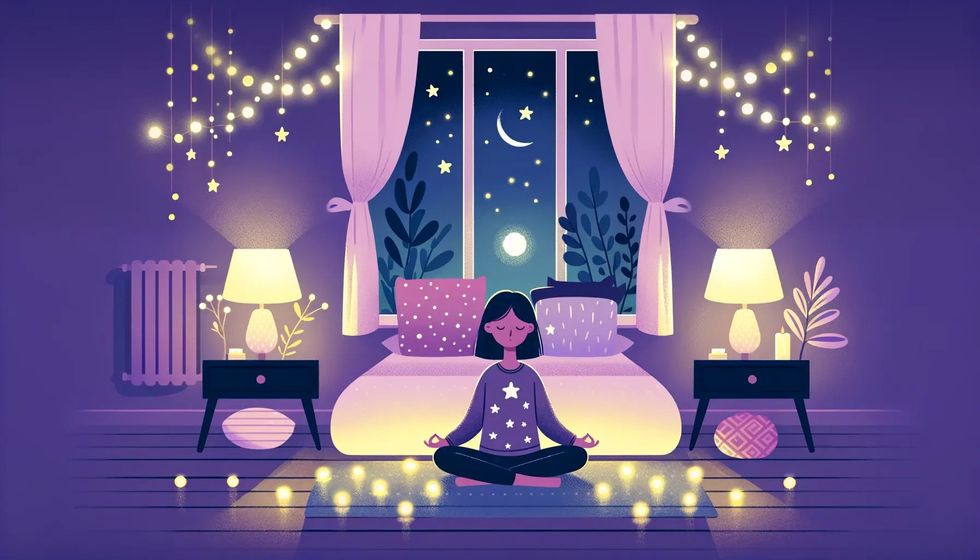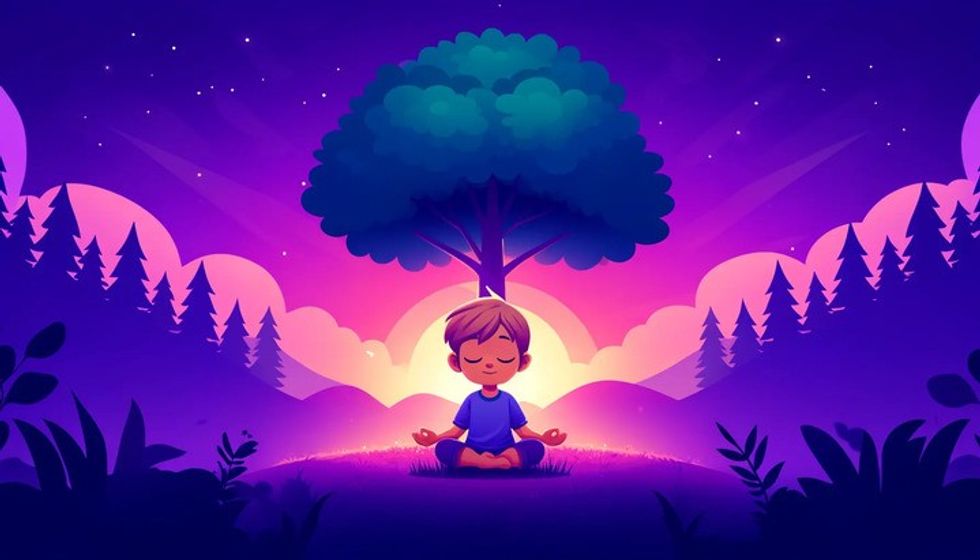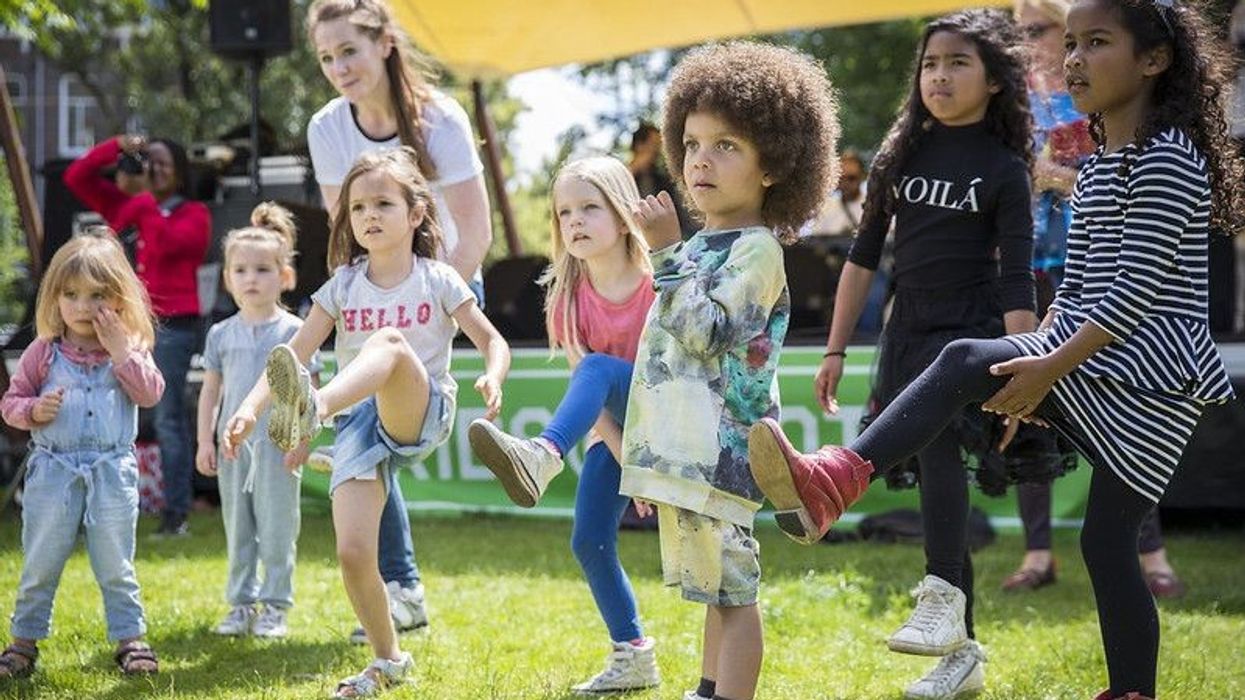When the day is winding down and evening arrives, it's not always easy for kids to settle in for bedtime. With active minds full of thoughts and energy from playing and learning, falling asleep can be a challenge.
This is where guided sleep meditation for kids can make a difference. These simple practices use calm narration and imaginative visualizations to relax restless bodies and busy brains. More than just a meditation exercise, guided sleep meditation becomes a soothing practice that helps the transition from an exciting day to a peaceful night's slumber.
By focusing young minds on serene imagery and gentle breathing, sleep meditation creates a relaxed space that naturally prepares kids for the restful sleep they need. Discover the calming benefits of this bedtime tradition that can transform the evening routine.
What is guided sleep meditation for kids?

Guided sleep meditation for kids is a technique that uses storytelling, visualization, and breathing exercises to help children relax and fall asleep. It involves a narrator guiding the child through a peaceful and calming experience, often with soothing music or sounds, to create an environment conducive to sleep.
- Calm narratives take children on a journey through peaceful scenes, helping them visualize relaxing environments and shift focus away from anxious thoughts.
- Breathing exercises in these meditations encourage kids to breathe deeply and slowly, which aids in calming the mind and body before sleep.
- Techniques like progressive muscle relaxation teach kids to release tension by relaxing muscles progressively from their heads to their feet.
- Mindfulness in meditation helps children stay present and lessen bedtime worries by acknowledging thoughts and feelings without judgment.
- Guided sleep meditations for kids are accessible via apps, videos, and audio tracks, making it easy for families to integrate them into their bedtime routines.
Establishing A Soothing Bedtime Routine With Meditation
Creating a calming bedtime routine with guided sleep meditations helps children wind down consistently before bed. Practicing meditation as part of the nightly ritual builds healthy sleep habits and ensures a peaceful transition into restorative slumber every night.
- Set a regular bedtime to help your child's body recognize when it's time to sleep.
- Include calming activities like reading a story or listening to soft music as part of the routine.
- Introduce short, guided meditations to help your child relax and prepare for sleep.
- Make the bedroom a cozy and inviting space, free from distractions like TV and other electronics.
- Be patient as your child gets used to meditation, and be willing to adapt the routine to fit their needs.
Types Of Guided Sleep Meditations For Children

Guided sleep meditations come in various forms, each designed to help children relax, unwind, and drift off to sleep peacefully. This section explores the different types of guided sleep meditations suitable for children.
- Guided meditation involves a narrator leading the child through relaxing visualizations or instructions. It is effective for ages 8 and up and includes engaging stories or scenarios.
- Mindfulness meditation focuses on being present and is suitable for ages 3 and above. It incorporates deep breathing exercises to calm the mind and body.
- Mantra meditation uses the repetition of a word or phrase to focus the mind and reduce distractions. It is appropriate for ages 3 and up and can be tailored to the child's needs with mantras like "I am thankful" or "I am loved".
- Sleep stories are narrated tales that help children relax and drift off to sleep. They include adventure, fantasy, or calm scenarios to engage the imagination and promote relaxation.
- Sleep sounds and music create a peaceful environment conducive to sleep through calming sounds or gentle melodies.
Tips For Choosing The Right Meditation For Your Child
Selecting the right guided sleep meditation for a child is important to ensure a good experience. This section discusses key things to think about when choosing a meditation, like the child's age and how long they can pay attention.
- Different meditations suit different age groups. Younger children might enjoy shorter, story-based meditations, while older kids may prefer longer sessions with more focus on mindfulness or relaxation techniques.
- Choose a meditation length that matches your child's ability to focus. Shorter meditations are usually better for younger children or those with shorter attention spans.
- Select meditations with themes or stories that interest your child. Engaging content keeps them interested and helps them look forward to meditation time.
- Ensure the meditation instructions are easy to follow. Simple, clear guidance helps children understand what to do and stay focused throughout the session.
- A peaceful setting enhances the meditation experience. Make sure the meditation space is quiet, comfortable, and free from distractions.
Creating A Conducive Environment For Sleep Meditation

Creating the right environment for sleep meditation can significantly enhance its effectiveness, helping your child relax and drift off to sleep more easily. Here are some tips to create a conducive space for sleep meditation.
- A dark, cool room promotes better sleep. Consider using blackout curtains to block out light and adjusting the temperature to a comfortable, cool setting.
- Minimize noise as much as possible. You can use a white noise machine or a fan to create a consistent, soothing background sound that drowns out other distractions.
- A comfortable mattress, pillows, and blankets can make a big difference. Choose bedding that's soft and cozy, making the bed a welcoming place for your child.
- Encourage your child to avoid screens for at least an hour before bedtime. The blue light from screens can interfere with the body's natural sleep cycle.
- Gentle, relaxing scents can help create a soothing atmosphere. Consider using a diffuser with lavender or chamomile essential oils, known for their calming properties.
Incorporating Mindfulness Into The Bedtime Routine
Integrating mindfulness practices into a child's bedtime routine can increase the benefits of guided sleep meditation. These are the various ways to incorporate mindfulness into your child's sleep routine.
- Start with mindful breathing exercises, focusing on deep inhalation through the nose and slow exhalation through the mouth, to calm the mind and body.
- Guide your child through a body scan meditation, asking them to notice sensations and consciously relax each body part from their toes to their head.
- Incorporate a moment of gratitude, encouraging your child to reflect on one or two positive experiences from their day.
- Try mindful storytelling, choosing stories that incorporate mindfulness lessons or practices within the narrative.
- Conclude with a guided imagery exercise, describing a peaceful scene for your child to visualize, promoting relaxation and readiness for sleep.
Addressing Common Sleep Challenges With Meditation

Guided sleep meditation can be a valuable tool for addressing some common sleep challenges that children face. Here's how it can help with issues like difficulty falling asleep and nighttime fears or worries.
- It eases anxiety and stress by using guided sleep meditations that help children manage bedtime worries. Focusing their attention on calming narratives or breathing exercises reduces anxiety and makes it easier to fall asleep.
- It creates a relaxing bedtime ritual by establishing a meditation routine. This signals to the child's body that it's time to wind down, creating a sense of safety and predictability, which is especially comforting for children who struggle with sleep.
- It improves sleep quality through the regular use of guided sleep meditations. These help children relax their bodies and minds, making it easier to fall asleep and stay asleep throughout the night.
- It addresses specific fears by designing guided meditations to tackle fears or concerns that may keep children awake. For example, they might include a story that reframes a common fear, such as the dark, into something positive and less intimidating.
- It teaches breathing techniques through guided meditations that often incorporate breathing exercises. These help children learn to control their breathing, a useful skill for calming the nervous system and promoting relaxation at bedtime.
The Long-Term Effects Of Regular Sleep Meditation Practice
Regular practice of guided sleep meditation can lead to several long-term benefits for children, contributing to their overall well-being and development. Here are some of the key long-term effects.
- Children can sleep deeper and more restfully when they meditate, which has been demonstrated to enhance the quality of their sleep.
- Children who practice meditation benefit in areas that need focus, such as academic achievement, by developing their attention span and concentration.
- Children who frequently meditate can better handle stress and have reduced levels of anxiety because it can be a useful strategy for controlling stress and anxiety.
- Children who practice mindfulness and meditation are better able to regulate their emotions, which results in calmer conduct and fewer sleep disturbances.
- By learning to observe thoughts without judgment, children may develop a healthier self-image and improved self-esteem through meditation, promoting better mental health and well-being.
- Regular meditation promotes adequate sleep, which is connected to several physical health benefits, such as improved growth and development and a stronger immune system.
- Children who practice meditation have stronger coping mechanisms, more adaptable problem-solving techniques, and the ability to be mindful and in the moment.
- By lowering stress and enhancing emotional regulation, meditation can have long-term protective effects on mental health by reducing the likelihood of mental health problems later in life.
FAQs
Can sleep meditation make my child fall asleep faster?
Yes, sleep meditation can help some children fall asleep more quickly by engaging their attention in a calm and soothing narrative. This distraction from daily activities and anxieties allows them to relax and smoothly transition into sleep.
How long does a typical kid's sleep meditation last?
A typical kid's sleep meditation can last anywhere from a few minutes to about half an hour. The duration often depends on the child's age and their ability to remain engaged, with shorter sessions recommended for younger children and longer ones for older kids.
Is guided meditation safe for all ages?
Yes, guided meditation is a gentle, non-intrusive practice that is good for people of all ages, even little ones. It has no adverse effects and instead encourages relaxation and stress reduction.
Can kids do guided sleep meditation by themselves?
Yes, children can perform guided sleep meditation by themselves, particularly with the aid of apps or recordings that provide easy-to-follow instructions. This independence helps them develop autonomy and comfort in their own relaxation process.
How often should kids do guided sleep meditations?
For the best results, incorporating guided sleep meditations into a child's nightly bedtime routine is recommended. Regular practice can help establish a consistent pattern of relaxation and sleep readiness, contributing to improved sleep quality and overall well-being.
By making guided sleep meditation a consistent bedtime routine, kids learn valuable skills like being mindful, managing emotions, and persevering through challenges. These important tools extend beyond just helping them sleep better at night.
Establish this nightly practice, and you'll see your children blossom into resilient individuals who awaken refreshed and ready to take on each new day.
Related Articles Around the Web













